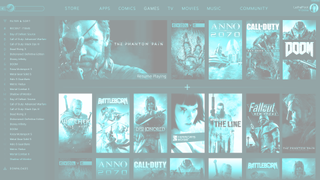If Valve wants to make Steam the best it can be, these issues are a good place to start

In the early days of the iPhone, the App Store was a paradise for indie game developers. There was a brief, golden opportunity to strike it rich. Of course, things changed—thanks to issues with curation, cloned games, free-to-play models, and perhaps most of all, volume. In the past few years, Steam has run into those exact same issues, with Steam Direct adding to the flow of new games. It's expected to top 6,000 this year. Steam is still a good place to buy games and organize a collection, but it's becoming increasingly clear how much better it could be.
On Friday we published a survey about Steam organized by indie developer Lars Doucet, with input from 230 developers on the state of Steam as PC gaming's biggest platform. The survey responses don't paint the picture of a store in crisis, but they do highlight some important issues that affect game developers. And, by extension, everyone who buys games on Steam. Out of 71 issues voted and commented on by developers, the top 10 offer us insight into where Valve can focus its efforts to make Steam better.
Curation, curation, curation
Competition is a clear concern for most indie developers on Steam; 52 percent of those surveyed ranked high-quality competition on Steam as a major threat, while 43 percent ranked competition from low quality games—aka shovelware—as a major threat.
"I believe Valve is not doing enough to stem the tide of games of questionable quality on its platform at the detriment of developers who want to make a difference," commented one surveyed developer.
"Valve needs an Amazon-like ability to recommend less popular games to users (current rec algo seems to be pretty terrible), otherwise they're going to continue to see this iOS Appstore-like race to the bottom where 1 percent of games occupy the spotlight and the other 99 percent languish with no visibility," wrote another.
Many of the comments in the survey echo criticism we've frequently seen of Valve: that it's relying on algorithms, and users, to do its curation. At least Valve is trying to make changes here, and the update to the Curator system, announced Thursday, is a first step. But clearly many developers feel larger structural changes are necessary. I'm skeptical that any algorithm, and Valve's planned "Explorers" program, in which community volunteers judge games, will be enough to curate the growing storefront. 10,000 games could realistically be released on Steam in 2018. Explorers and curators won't be enough.

Organizing for the Steam Direct era
More than 70 percent of developers in the survey agreed that Steam's "Upcoming games" list is becoming useless. On the store, the Upcoming list is the only way to easily discover soon-to-be-released games, but the volume of releases on the list, including shovelware, has made it a poor resource. It's overwhelming.
The biggest gaming news, reviews and hardware deals
Keep up to date with the most important stories and the best deals, as picked by the PC Gamer team.
"The 'upcoming games' list used to be a major way to find out about new titles but there are now so many that it is becoming clogged. Not only is there lots of new stuff, but we often see a growing list of titles parked here week after week. If the discovery feature is meant to work, it needs to gather some initial data about new games, otherwise it’s just blindly promoting things that came into the store with existing buzz," writes one developer.
A similar dev opinion: "With LOW quality games, it's not 'competition' per se.. it's more that overall visibility is hurt due to the massive influx of crappy games taking up the Upcoming List and taking visibility bandwidth from legitimate developers."
Improved discoverability is better for everyone
Rethinking how Steam presents upcoming games could feed into another highly supported issue, with 65 percent of survey respondents in favor and only 5 percent against: Valve taking actions to increase the overall volume of sustainable middle class developers. "A robust population of mid-tier developers means great, polished, innovative games keep being made. And those generate the new PC hits and fresh hit genres," wrote one developer.
This year we've seen the results of increasingly expensive triple-A development, and what publishers will do to increase profits. Loot boxes are everywhere, and singleplayer games like Visceral's Star Wars project are changing direction to keep players playing (and, likely, paying) for weeks or months. Singleplayer games are never going away completely, but indie and mid-size developers are going to be a vital ingredient of a diverse, creative PC gaming scene. For that scene to thrive, Valve has to fully embrace its responsibility to making Steam better for developers and players alike.

Some of the developer suggestions in this survey are simply practical ways Valve could help developers put their games in front of more eyes. Integrating bug reporting into Steamworks would free up development time currently spent troubleshooting errors that actually come from Steam, rather than their games. Unified landing pages and community forums would make it easier for fans to follow their games. Developers currently can't get traffic breakdowns per region, a vital bit of data as Steam grows internationally (especially in China).
"My last game did very well on Germany/Poland but was completely buried in the US/UK. The only way I know that is because I used various proxies to look at the front page and the various new releases list, using a German proxy my game was on the trending list, using a US proxy it was nowhere to be seen," one developer wrote.
Taking action
It's time for Valve to prove it takes this kind of feedback seriously and plans to make changes for the better, even if those changes aren't exactly what developers are asking for. In 2016, Lars Doucet organized a similar survey and sent the results to Valve. Of last year's top 10 issues, as voted on by developers, only three have been addressed. Some good, straightforward ideas remain: "Add an 'open in Steam client' button on any Steam webpage, when viewed outside of the Steam client browser." "Add embeddable 'add to Steam wishlist' buttons for the web." "Players should be able to 'follow' developers on Steam."
Users have their own priorities for what would make Steam a better store, but many of the things developers want would make games easier to find, follow, and keep the PC community healthy—all good things for those of us who play games, instead of make them.
According to the survey, only 39 percent of developers currently believe Valve is earning its cut of sales; 59 percent of those respondents thought that Valve did earn its share at some point in the past. To turn that number around, Valve has a great collection of feedback at its disposal in the full report. It's about time they start acting on it.

Wes has been covering games and hardware for more than 10 years, first at tech sites like The Wirecutter and Tested before joining the PC Gamer team in 2014. Wes plays a little bit of everything, but he'll always jump at the chance to cover emulation and Japanese games.
When he's not obsessively optimizing and re-optimizing a tangle of conveyor belts in Satisfactory (it's really becoming a problem), he's probably playing a 20-year-old Final Fantasy or some opaque ASCII roguelike. With a focus on writing and editing features, he seeks out personal stories and in-depth histories from the corners of PC gaming and its niche communities. 50% pizza by volume (deep dish, to be specific).
Most Popular

